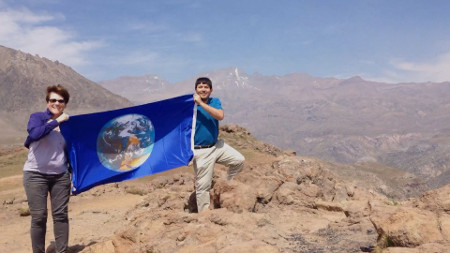BMSIS SCIENTIST FEATURE: Dr. Armando Azua-Bustos
Blues for a red planet: Dr. Azua-Bustos uses a unique approach to understand life in the extreme environment of the Atacama Desert
by Rabeea Rasheed
Our knowledge of life is based on our observation and understanding of organisms living on Earth or that lived here in the past. The complexity and diversity of life developed over the course of a million years. From the tiniest microbe to the mighty blue whale, Life evolved and adapted to its environment.Biological diversity includes the diversity of genes, species and ecosystems. However, with the discovery of life in extreme environments, such as in hot springs and on glaciers and at the bottom of the ocean, our perspectives on life, its limitations, and diversity has widened. Scientists have found life in many of Earth’s most inhospitable surface environments. Now we have a better understanding about the competence of life to withstand and adapt to its environment. Extremophiles have helped us to understand the boundaries of life on Earth, through physical parameters such as temperature, pH, salinity, and pressure.Astrobiologist and BMSIS research scientist, Dr. Armando Azua-Bustos, who was born and raised in the vast and arid land of the Atacama Desert now studies the strangest life forms that live there. Dr. Azua-Bustos has always been interested in intellectually challenging stuff. He is using the Atacama Desert as a model for the exploration of Mars. Scientists have often used this desert to study the possibility of life on the Red Planet, and Armando’s ultimate goal is to apply his findings in the search for life elsewhere. In his very own words, ‘’leaving the ground and going to space’’.
Armando has a wide array of research and collaboration experience. He obtained his B.Sc. in Agronomical Sciences at Pontifical Catholic University of Chile in 1996 and his Ph.D. in Molecular Genetics and Microbiology from the same university in 2013. He was awarded a NASA Group Achievement Award in 2007 and has been working as Scientific Adviser to the Senate of Chile since 2015. Dr. Azua-Bustos is also a Research Scientist at the Center of Astrobiology of CSIC, Madrid, Spain.

While working on his Ph.D., Armando got in contact with Chris McKay, of NASA Ames Research Center, and together they conducted research projects in the Atacama. Armando is now a Co-Investigator in an initiative led by Dr. McKay where the core goal is to send a greenhouse to Mars or the Moon. These experiments could illuminate whether human settlement of these worlds could be possible.
Dr. Azua-Busto’ main interest in research is to understand the close relationship between water and life and understanding the adaptations of microbial life to extremely low water availability. He also works on developing the biotechnological applications of the microbes and plants of the Atacama while exploring how life evolves and adapts in such an extreme environment. And, in order to evaluate the limits of Earth’s life and advance our understanding of the potential for life elsewhere, Armando has spent several years of his life studying the Atacama and its implications for the Red Planet.
The Atacama Desert, where he spent most of his life, is thought to be one of the driest and sterile places on the surface of planet Earth. Dr. Azua-Bustos investigated and found several species living in this extreme environment, where most life forms would wither. During his field work, he found something very amazing about microbes living on a spider’s web. He discovered that these microbes depend on dew drops on the web for their survival. The Atacama is the driest place on Earth’s surface (the only water vapor comes from the fog present in the air overnight), and Armando discovered that microbes drink dew and survive in this harsh environment.
Another notable discovery in the Atacama by Dr. Azua-Bustos showed that some bacteria and fungi traveled within dust particles across the desert, carried by the wind from different locations. Within these dust particles, Azua-Bustosand his team discovered 23 bacterial and 8 fungal species from different regions of the Atacama. Later they showed that those bacterial and fungal species originated from the desert’s coastal range and the Pacfic Ocean and were likely carried to the desert by aeolian transport (being blown on the winds).
Dr. Azua-Bustos has received numerous awards and is widely recognized for his work around the world. His work has been published and appreciated in many international journals. He appeared in many documentaries based on his research work on extremophiles, astrobiology, and astronomy. In 2013, he wrote an astrobiology book for kids entitled ‘’Are we alone among aaaall these stars?’’ Furthermore he has co-authored many book chapters and has delivered 3 TED talks. He has done extensive research in the field of microbiology in extreme environments and astrobiology. His hard work and dedication to do something different guided him to contribute in one of the finest fields of science. In his TED talk, he said, ‘’while everybody else will be looking among the stars, to answer the question, ‘’are we alone?’’ I’ll be looking down to the ground, searching for the same answer in my own backyard.
Rabeea Rasheed is a Visiting Scholar at BMSIS. Rabeea is a science communicator and educator at Lahore Grammar School in Pakistan. She is also International Committee member of NoR CEL.
